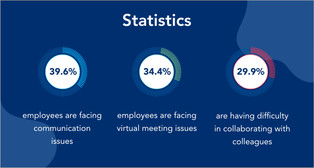80% Leaders Shifted to Placeless Mindset: What stops the rest of the 20%?
- mak bhave

- Mar 30, 2021
- 3 min read
Updated: Apr 14, 2021

In March 2021, we completed one year of the pandemic! With it, we see the ‘New Normal’ the corporate has adopted – Telecommuting. Yet the conundrum exists!
Whether to become a remote-first organization or not? Organizations such as Google and Facebook have declared to go remote forever, then what bothers startups and SMEs not to do so!
Let us dig these doubts and apprehensions but before that let us understand what the ‘Placeless Mindset’ is!
What is a Placeless Mindset?
A Placeless mindset refers to a comprehensive approach toward work and life. It goes beyond the simple work-life balance.
“A Placeless Mindset is a keen understanding that our lives, and therefore our work, are not rooted in a singular place, but rather require flexibility in location and communication to balance multiple goals and priorities.”

We can also relate it to the fixed mindset and growth mindset, where the placeless mindset represents growth.
Three Pillars that Help to Overcome Apprehensions about Placeless Mindset
Pillar 1 - Trust between employees and employer
What matters to the employers? Achieving the deliverables or watching your employees working.
We are sure all of you would choose the first one! But you might have following reasons for not being remote –
This brings us to the first pillar of a placeless mindset – Building efficient processes!
Explain your team that you share one vision, achieving that goal is of the utmost priority
Train them to proactively communicate, give enough time to respond
Let employees have independent work time, only restricted to deadlines
Foster online team activities and collaboration at regular intervals to keep work culture intact
Pillar 2 - A proper place to work
This is one debatable point about remote working. Most of the employers are of the mindset that offices are the best to work. The reasons being –
What happens when you let your employees work remotely – it increases job satisfaction rate, the second pillar of placeless mindset!
Give liberty of time and space to work so they can be optimally productive
Ensure they have efficient systems and uninterrupted connectivity
Schedule daily scrum calls to keep check on work progress
Appreciate ad reward team members for their achievements to keep them motivated
Pillar 3 - Competencies
This is not very hard to understand why a lot of employers do not want to go remote-first!
What happens when you let your employees work remotely – it increases job satisfaction rate, the second pillar of placeless mindset!
Employees do not understand verbal instructions clearly on call
Emails and chats do not convey the right emotions as they do in a face-to-face conversations
Employees hide behind the call, side-lining the responsibilities
Yes, these problems do occur because the focus is completely on technical skills and knowledge. Employers must similarly focus on the soft skills and Emotional Quotient of the employees to overcome the challenges of a distributed team.
Inculcate correct and efficient communication habits, including email writing skills
Make teams understand that they need to be accountable for their work
Empathy and supportiveness toward team members go long way to work in sync and as a team
Be objective-analytical and let the emphasis be on logic and fact-based evaluation over feelings
Conclusion
Though remote work is widely accepted by the leaders, its efficiency completely depends on the attitude of the leaders and teams. Transition to a Placeless Mindset cannot be sudden, but it will be surely easier with the three pillars – process-centric culture, sufficient time and space, and people skills!
Get in touch with us to find out more.
Resources
Resource 1: https://cutt.ly/bx0NZr5
Resource 2: https://cutt.ly/Px0NBmx
Resource 3: https://cutt.ly/9x0N1IY
Resource 4: https://cutt.ly/6x0N8lo
Resource 5: https://cutt.ly/Yx0MwpP

















Comments